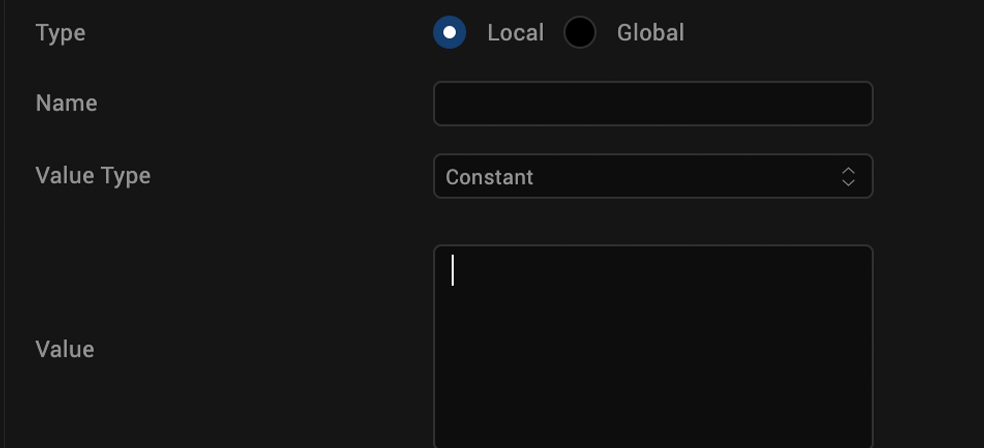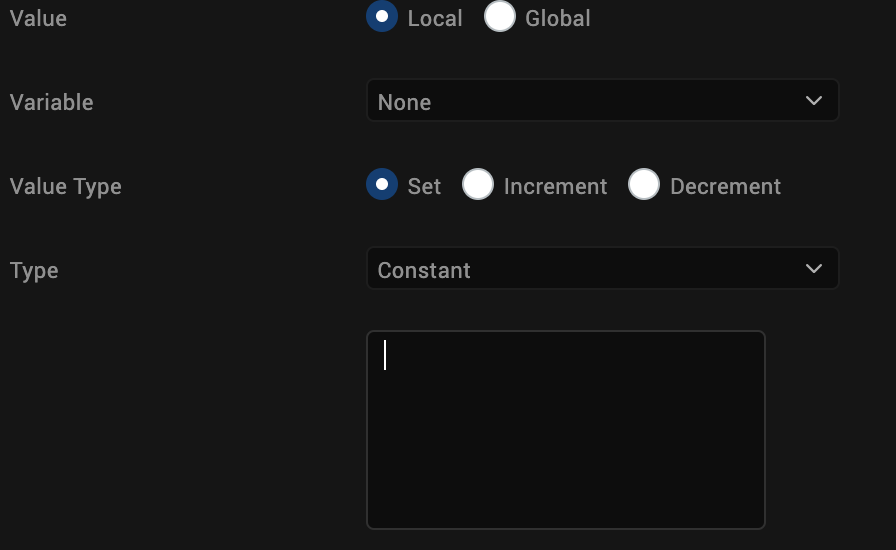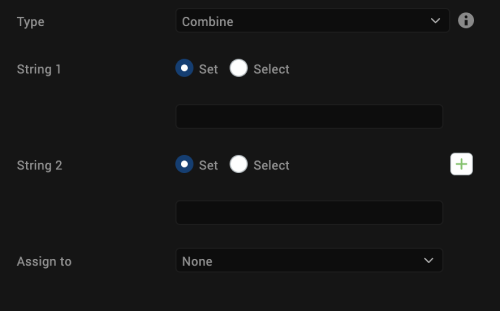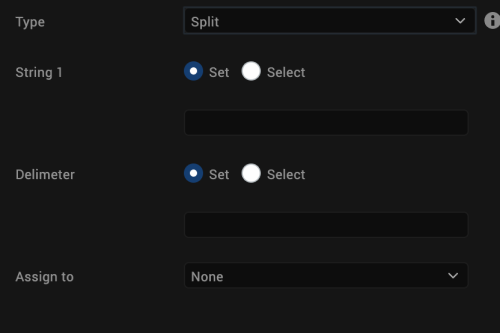General
General Actions
The general actions that you can use in an action sequence are as follows:
| Action | Property |
|---|---|
| Loop Action | Repeat a set of nested statements for the specified number of times. |
| Add Variable | Adds a variable that is available within a function. Local variable can be of type Constant or Expression and take the following data type: String, Number, Boolean and or Collection. |
| Modify Variable | Modify an existing variable. |
| Navigate to Form | Navigates from one form to another. |
| String Operation | Perform operations (such as combine or split) on strings. |
| Try-Catch | Marks a block of statements to try, and specifies a response, should an exception be thrown. |
| Exit App | Closes the application.(Not supported for Apple Watch) |
| Set Timeout | Set a timeout variable. |
| Clear Timeout | Clear the timeout. |
Loop Action
To define an action sequence for executing a loop action, do the following:
- From the Project tab of the Project Explorer, select the widget you want to apply the action to.
The widget is highlighted on the Iris Canvas. - Right-click the widget and then select one of the actions for example, onTouchStart.
The Action Editor window opens and an action sequence is created. - From the General section along the left column of the Action Editor, click Loop Action.
The action is added to the action sequence and is the current action of focus. -
In the properties pane of the Action Editor, configure the following
- In the Variable field, you can either select
setand enter a name for the variable or selectselectand select a variable from a list of existing variables. - In the Starting Value field, you can either select
setand enter a starting value for the variable or selectselectand select a value from the list. - In the End Value field, you can either select
setand enter an ending value for the variable or selectselectand select a value from the list. - In the Step By field, enter the value for the step.
-
Select the direction of the count, either
IncrementorDecrement.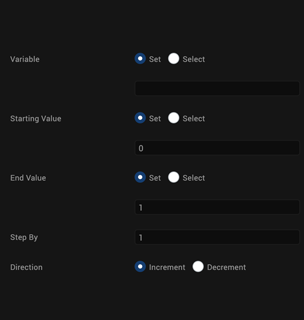
- In the Variable field, you can either select
-
Click Save to save the action sequence, and close the Action Editor window.
Add Variable
To define an action sequence to add a local variable, do the following:
- From the Project tab of the Project Explorer, select the widget you want to apply the action to.
The widget is highlighted on the Iris Canvas. - Right-click the widget and then select one of the actions for example, onTouchStart.
The Action Editor window opens and an action sequence is created. - From the General section along the left column of the Action Editor, click Add Variable.
The action is added to the action sequence and is the current action of focus. - In the properties pane of the Action Editor, in the Name text box, enter a name for the variable.
- From the Value Type list, select a value type, either Constant or Expression.
-
In the Value field, enter the value of the local variable.
-
Click Save to save the action sequence, and close the Action Editor window.
Modify Variable
To define an action sequence to modify an existing variable, do the following:
- From the Project tab of the Project Explorer, select the widget you want to apply the action to.
The widget is highlighted on the Iris Canvas. - Right-click the widget and then select one of the actions for example, onTouchStart.
The Action Editor window opens and an action sequence is created. - From the General section along the left column of the Action Editor, click Modify Variable.
The action is added to the action sequence and is the current action of focus. - In the properties pane of the Action Editor, in the Value field, select
Localto modify a local variable, orGlobalto modify a global variable. - In the Variable field, select a variable from a list of existing variables.
- In the Value Type field, you can choose to either
seta value for the variable orIncrementorDecrementthe value of the variable.
If you choose to set a value for the variable, select a value type from the Type list, either Constant or Expression, and then enter the value of the variable in the text box provided below.
Click Save to save the action sequence, and close the Action Editor window.
String Operation
To define an action sequence to execute a String operation, do the following:
- From the Project tab of the Project Explorer, select the widget you want to apply the action to.
The widget is highlighted on the Iris Canvas. - Right-click the widget and then select one of the actions for example, onTouchStart.
The Action Editor window opens and an action sequence is created. - From the General section along the left column of the Action Editor, click String Operations.
The action is added to the action sequence and is the current action of focus. - In the properties pane of the Action Editor, in the Type field, select the type of String operation, either Combine or Split.
- In the String 1 field, you can choose to either
seta value for the string or selectselectand select a string from a list of existing strings. -
The second field varies depending on the type of String operation you select.
-
If you select the Combine option, in the String 2 field, you can choose to either
seta value for the string or selectselectand select a string from a list of existing strings. To add additional strings, click the green + icon. To delete a string, click its corresponding red x icon. -
If you select the Split option, in the Delimiter field, you can choose to either
seta delimiter for the string or selectselectand select a string from a list of existing strings.
-
-
In the Assign To list, select the variable to which you want to assign the resulting String.
- Click Save to save the action sequence, and close the Action Editor window.
Try-Catch
To define an action sequence to execute a try-catch block of code, do the following:
- From the Project tab of the Project Explorer, select the widget you want to apply the action to.
The widget is highlighted on the Iris Canvas. - Right-click the widget and then select one of the actions for example, onTouchStart.
The Action Editor window opens and an action sequence is created. - From the General section along the left column of the Action Editor, click Try-Catch.
The action is added to the action sequence and is the current action of focus. -
In the properties pane of the Action Editor, three actions are available:
- The try statement allows you to define code to be tested for errors while it is being executed. Add the action or actions that you want to carry out in the try block by locating and clicking the action from the list of actions available along the left column of the Action Editor.
- The catch statement allows you to define a block of code to be executed, if an error occurs in the try block. In the code editor, enter the code that you want to execute or paste it in from another source by pressing Ctrl+V. For Apple Watch, you can also add the action or actions that you want to carry out in the catch block by locating and clicking the action from the list of actions available along the left column of the Action Editor.
- The finally statement lets you execute code, after try and catch, regardless of the result. Add the action or actions that you want to carry out in the finally block by locating and clicking the action from the list of actions available along the left column of the Action Editor. (Finally is not supported for Apple Watch)
-
Click Save to save the action sequence and close the Action Editor window.
Navigate to Form
To define an action sequence for navigating to a form, or exit an app, do the following:
- From the Project tab of the Project Explorer, select the widget you want to apply the action to.
The widget is highlighted on the Iris Canvas. - Right-click the widget and then select one of the actions for example, onTouchStart.
The Action Editor window opens and an action sequence is created. - From the General section along the left column of the Action Editor, click Navigate to Form. The action is added to the action sequence and is the current action of focus.
-
In the properties pane of the Action Editor, select the form to navigate to.
-
Click Save to save the action sequence, and close the Action Editor window.
Exit App
Exit App is not supported for Apple Watch. To define an action sequence for exiting an app, do the following:
- From the Project tab of the Project Explorer, select the widget you want to apply the action to.
The widget is highlighted on the Iris Canvas. - Right-click the widget and then select one of the actions for example, onTouchStart. The Action Editor window opens and an action sequence is created.
- From the General section along the left column of the Action Editor, click Exit App. The action is added to the action sequence and is the current action of focus.
- Click Save to save the action sequence and close the Action Editor window.
Set Timeout
To define an action sequence to set a timeout, do the following:
- From the Project tab of the Project Explorer, select the widget you want to apply the action to.
The widget is highlighted on the Iris Canvas. - Right-click the widget and then select one of the actions for example, onTouchStart.
The Action Editor window opens and an action sequence is created. - From the General section along the left column of the Action Editor, click Set Timeout.
The action is added to the action sequence and is the current action of focus. - In the properties pane of the Action Editor, in the Delay (s) field, enter a value for the time in seconds (s) after which the timeout must occur.
- In the Assign To list, select the variable that you want to use to set the timeout.
-
For Repeat, select either
TrueorFalseto choose whether or not the timer will repeat. -
Click Save to save the action sequence, and close the Action Editor window.
Clear Timeout
To define an action sequence to clear a timeout that has already been set, do the following:
- From the Project tab of the Project Explorer, select the widget you want to apply the action to.
The widget is highlighted on the Iris Canvas. - Right-click the widget and then select one of the actions for example, onTouchStart.
The Action Editor window opens and an action sequence is created. - From the General section along the left column of the Action Editor, click ClearTimeout.
The action is added to the action sequence and is the current action of focus. -
In the properties pane of the Action Editor, from the Timeout Handle list, select the variable for the timeout you want to clear.
-
Click Save to save the action sequence, and close the Action Editor window.
